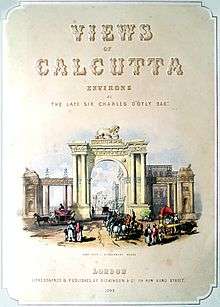Charles D'Oyly



Charles D'Oyly (1781–1845), was a British public official and painter from Dhaka who produced numerous images on Indian subject matter.
Life
He was born in India on 17 September 1781. His father, Sir John D'Oyly, 6th Baronet was the resident of the East India Company at the Court of Nawab Babar Ali of Murshidabad. D'Oyly went to England with the family in 1785 and received his first formal education there. In 1798 he returned to India as Assistant to the Registrar in the Court of Appeal in Calcutta. In 1803 he was appointed as 'Keeper of the Records' in the office of the Governor General.[1]
D'Oyly was appointed as the Collector of Dacca (now Dhaka) in 1808. In the following years, posts he held were the Government and City Collector of Customs in Calcutta (1818), the Opium Agent of Bihar (1821), the Commercial Resident of Patna (1831) and lastly the Senior Member of the Board of Customs, Salt, Opium and of the Marine (1833). After serving with the company for forty years, his failing health compelled D'Oyly to leave India in 1838. After the death of his father, D'Oyly inherited the baronetage and received a knighthood. The greater part of the rest of his life was spent in Italy and he died there on 21 September 1845 leaving no male issue.
D'Oyly was Collector of Dhaka from 1808 to 1817. During that period, he painted a wide variety of pictures, especially the Mughal ruins. He decided to publish the drawings relating to Dhaka in the form of a folio-size book. After engraving, the drawings of D'Oyly were published in London from 1823 onwards. A short historical account of Dhaka was also appended to each book. James Atkinson wrote these accounts, accompanied by engravings done by Landseer. These books came to be known as Antiquities of Dacca and became important social documents.
D'Oyly collaborated with Christopher Webb Smith in producing a number of books. Two of these were Feathered Game of Hindostan (1828) and Oriental Ornithology (1829), Webb Smith depicting the birds and the foliage, and D'Oyly doing the backgrounds.[2]
Between 1832 and 1833, D'Oyly took leave at the Cape of Good Hope, returning to Calcutta to fill the post of Senior Member of Customs, before retiring in 1838.
In 1848 Dickinson & Co., 114 New Bond Street, London, published D'Oyly's Calcutta drawings in a large folio-size book titled Views of Calcutta and its Environs The original drawings for this work were probably made between 1833 and 1838 while D'Oyly was Senior Member of the Board of Customs, Salt, and Opium and Marine Board in Calcutta, but some must have been completed between 1839 and 1845 when he retired. The complete work was published after D'Oyly's death in Italy in 1845.
| Wikimedia Commons has media related to Charles D'Oyly. |